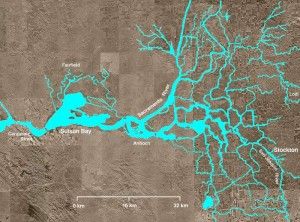Delta Council Meetings Flood State
By WAYNE LUSVARDI
Is the Delta Stewardship Council:
- A bunch of environmentalists appointed by politicians to produce endless numbers of useless plans to restore the Sacred Delta Ecology;
- A group of water agencies serving the thirsty cities of Southern California to pull off a water grab of Northern California water; or
- A group of Delta landowners who are opposed to the use of eminent domain to take any of their land or water rights for water conveyance facilities for Los Angeles.
Correct answer: None of the above.
The Delta Stewardship Council is a state agency actually created by the California Legislature in 2009 as part of the Delta Reform Act: Senate Bill SB X7-1. The council’s task is to devise a Delta Plan and Environmental Impact Report to accomplish what are called the “co-equal goals” of the legislature:
- Providing a more reliable water supply for California; and
- Protecting, restoring and enhancing the Delta ecosystem.
The Draft EIR that is now being vetted in different points around the state emphatically clarifies that “restoring the Delta” does not mean returning the Sacramento Delta and Suisun Marsh to a pristine condition by pulling out all the water pumping plants. According Keith Coolidge, a member of the Stewardship Council, shutting off all water pumps to farmers and Southern California cities wouldn’t restore the Delta anyway. He was speaking Thursday at an official meeting of the council held at the Pasadena Public Library.
Coolidge said the council’s mission is, “Not to sacrifice the Sacramento economy for the ecology, but also not to sacrifice the ecology for water supplies.”
The purpose of the meeting was to accept formal comments to the Draft EIR for the Delta Plan, which should be finalized in late spring 2012. Afterward, the council will finalize its Delta Plan, which will become enforceable law.
Diversification?
Emily Green runs a popular water blog, “Chance of Rain.” She asked, “If we’re going to be required to diversify water supplies, where is that diversification coming from?”
Here the council was evasive. Coolidge said there was not necessarily going to be a loss of water or a gain in water supplies.
But common sense dictates that, if there is equal footing between a) Delta eco-system restoration and b) supplying water for farms and cities, the farms and cities are going to have their water supplies cut, especially in dry years. The members of the council were adept at side-stepping this hot-button issue because the California Legislature has put them on the hot seat.
The maximum total amount provided to cities and farms under the State Water Project is 4 million acre-feet of water per year. That is 4 million football fields of water one foot high; or enough for 8 million households. Alternatively, it is enough irrigation water for 4 million acres of farmland. But the actual amount varies each year depending on Sierra snowpack and precipitation.
Southern California is entitled to a maximum 1 million acre-feet of water per year from the State Water Project.
Pasadena resident David Powell is the former head of the State Department of Water Resources’ San Diego Office and head of engineering for the Alameda County Water District. He previously told me that Southern California would likely suffer a cut of half of its water supplies under the Delta Plan.
Phil Isenberg, the Delta Stewardship Council’s chairman, clarified that the Water Code specifies two broad goals for the diversification of water supplies: conservation and greater efficiency. However, it does not spell out what type of conservation or water storage and conveyance facilities might eventually be built.
Isenberg emphasized that the council is an independent body that can formulate enforceable policies. But it does not have the power to levy taxes, fees and fines, or to authorize bonds. Those activities will still be done by the Legislature in tandem with voter approval, where required. Thus, voters will not be taxed without representation.
‘Covered Actions’
Nonetheless, there are still obscure parts to the Delta Plan. It requires state or local agencies to clear any actions that directly affect the Delta with the Delta Stewardship Council under what is bureaucratically called a “covered action.” Isenberg said that there were a lot of exclusions to what a “covered action” would pertain to. Unfortunately, the term “covered action” will likely be the butt of jokes as it sounds like “covert action.” What it really means is, “actions covered” by the Delta Plan.
I asked whether the Delta Plan, once enacted, would require revision of existing legislation on the books that conflicts with the new Delta Plan. No one on the council knew.
I asked, in particular, if SB 375 –- California’s “anti-sprawl” bill — requires that population growth be directed toward the urban coastline, which has sparse groundwater supplies. And I asked: If demands on Delta water are going to be lessened, would that mean diverting population growth to inland areas where there are more abundant groundwater supplies to rely on in dry years?
Staff legal counsel Chris Stevens replied that SB 375 is not one of the exemptions to the Delta Plan or “covered actions.” This might mean that all the hodge-podge of existing laws on the books that conflict with the Delta Plan might remain in place.
However, determining which environmental policy takes priority over the other is a job for the Legislature, not the Delta Council.
Values, Not Science
Unfortunately, the Delta Council has been given only vague directions by the Legislature as to how much freshwater, saltwater and brackish water habitat is desirable public policy for the Delta. As environmental scientist William Cooper has said, ecosystems such as the Delta can be operated as a freshwater habitat for salmon and sport fishing; a saltwater habitat for catfish and commercial fishing; a brackish water habitat for minnow such as the infamous Delta Smelt; or a mix of the above. The choice of the mix of these water habitats is not an issue that can be determined solely by science. They are cultural values; albeit there are some limits as to how much of each type of ecology can be engineered.
Unfortunately, the Legislature is still covering its actions with scientific justifications for what are unavoidable cultural and political value judgments. It is asking too much of scientists and too much of the Delta Stewardship Council.
It might behoove the Legislature to consider adding a water sociologist to help in developing what cultural values are important. Then Delta scientists can determine what is feasible and develop a before-and-after plan.
Isenberg also clarified that the proposed $11.1 billion Water Bond for the November 2012 ballot will not halt the adoption or enforcement of the Delta Plan or EIR. He said only some projects would be affected if funding were not provided.
Bureaucratic Restoration
The Delta Stewardship Council is not only tasked with repairing the Delta, but repairing its image around the state. To do this, it is holding meetings at various locations to take official comments to its Draft Plan EIR, even though it’s not required to do so.
The next meetings are:
Central California
Tuesday, January 17, 2012, 6 p.m.
Ceres Community Center, Large Assembly Room
2701 4th Street, Ceres, CA 95307
Delta
Wednesday, January 18, 2012, 6 p.m.
Clarksburg Middle School Auditorium
52870 Netherlands Road, Clarksburg, CA 95612
Northern California
Thursday, January 19, 2012, 6 p.m.
Willows City Council Chambers
201 North Lassen Street | Willows, CA 95988
Clarification
But the council might improve its public image if it clarified that it is the “California State Legislature’s Delta Stewardship Council,” not some presumed association of environmentalists, water agencies, farmers, Delta landowners and recreational fishing advocates. And that unfortunate bureaucratic term “covered actions” might have to be reconsidered.
If the Delta Council is going to be perceived as more than some secret society that shrouds its decisions in scientific language, the Legislature is going to have to do a better job of clarifying what it wants the Delta to look like before and after its proposed plan. In postmodern California, “science says” has become the equivalent of, “God willed it.”
The Delta Stewardship Council is working hard at restoring its public image and eventually re-engineering the Delta. But it’s going to need more clarification from the Legislature than the vague project alternatives detailing how much water should or should not be exported out of the Delta. It needs a vision and a map of what it wants the Delta to look like.
Related Articles
Not just in China: The corrupt act that got CA bullet train passed
April 12, 2013 By Chris Reed The news that the former head of China’s bullet-train program is facing corruption charges
Global Warming Proved a Fake
John Seiler: New research proves global warming a fake. If this state had any sense, it would repeal Gov. Arnold
Bullet-train officials praise judge they called a threat to CA
The California High-Speed Rail Authority got some good news from the courts last week. The 3rd District Court of Appeal




